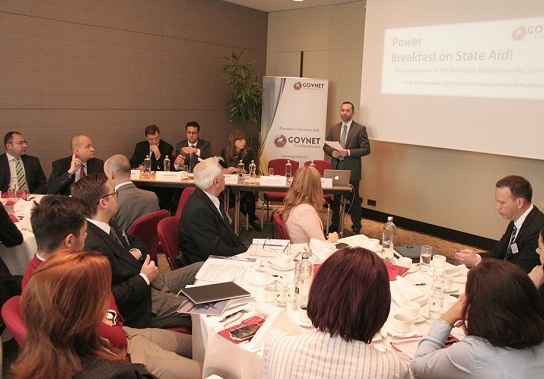State Aid procedure in the financial framework 2014-2020: GDs no. 332/2014 and 807/2014 at a glance

After seven years during which the Romanian State has provided funds of 800 million euro to the private sector under state aid schemes, the next multiannual financial framework 2014-2020 brings some important changes with respect to this form of non repayable financing: two Government Decisions, no. 332/2014 and 807/2014, that establish new directions in releasing state aids for regional development. All the practical aspects in terms of granting procedure, eligibility criteria, submission of requests for this funding opportunity have been discussed and explained by representatives of the Ministry of Finance within an event focused on state aid procedure organized by GOVNET Conferences.
The old schemes effective between 2007 and 2014 had been allocated a budget amounting to 2.3 billion euro, yet, only 30 percent (800 million euro) of these funds had been directed towards investment projects. According to the data provided by the Ministry of Finance, 71 projects in fields such as automotive, health, IT&C, renewable energy or research-development-innovation benefitted from state aid, the related investments with an aggregated value of 3 billion euro creating over 25,000 new jobs.
“The main objectives were to stimulate investment and create new jobs, but there were also less visible ones as attracting new technologies or engaging other beneficiaries – suppliers, clients of direct beneficiaries of state aid, and especially implementing business models both by SMEs and by the other companies involved, along with beneficiaries, in the development of such projects”, commented Livia Stan, General Director State Aid Department within Ministry of Public Finance.
She further explained that the Ministry maintains its policy in the state aid field for the following financial framework, yet, regional development becomes a priority, in line with the European directions. In this respect, after consulting the business environment, the GD no. 332/2014 and the GD no. 807/2014 were issued, regulating state aid procedure in Romania.
The two state aid schemes established by the GDs in question incorporate most of the provisions of the old programmes, however, they are more flexible, with extended eligible expenses, as outlined Enache Jiru, Secretary of State within the Ministry of Finance. The total funds allocated for each of these schemes in the next financial framework comes to 600 million euro, hence, 1.2 billion euro in total, provided in full from the State budget. The capital can be supplemented, if necessary, said Livia Stan, however the previous experience does not indicate it will be the case.
Aside from the potential beneficiaries, the state aid programmes mainly differentiate in terms of target investments: one of them is aimed at salary costs, whilst the other fits to acquisition of assets.
The Government Decision no. 332/2014 enforces the state aid scheme which supports the creation of at least 10 new jobs, of which minimum three for disadvantaged people, as a result of an investment project, the related salary costs for two consecutive years being considered eligible expenditures. Thus, more than 1,500 beneficiaries and about 35,000 new jobs are foreseen.
Except for sectors such as renewable energy or the others specified by the Community Regulations, all companies can apply for funds under this programme which has a budget of maximum 100 million euro per year. As the main objective is regional development, the share of non-reimbursable funds provided from the state budget ranges depending on the region where a project is implemented. Therefore, while in Bucharest region companies can receive at most 15 percent of the investment (between 2014 – 2017 and 10 percent in 2018 – 2020, respectively), in Ilfov and West regions the State grants up to 35 percent of the eligible expenditures, in the rest of the country, companies that request state aid benefiting from the maximum intensity allowed, 50 percent.
For companies to get approved state aid funds, there are specific criteria to be met, both in terms of their status and in terms of eligible expenditures. As Livia Stan explained, the following requirements must be concurrently fulfilled so that the corresponding expenditures are considered eligible and, therefore, disburse: jobs are created as a result of an investment project; jobs are created subsequent to receiving financing approval, but no later than three years after carrying out the investment project; the new employees should not be former employees of a company or its associated companies in the 12 months prior submitting application for state aid.
As regards the status of potential state aid beneficiaries, except from the basic requirements which must be met, such as not having outstanding debts to the State budget or being insolvent, companies must not be benefitting from any state aid for the same project and must prove credibility and financial stability.
Submission for funding requests under this state aid scheme has already been opened and it will close on November 28, 2014. Starting with 2015, the Ministry of Finance envisages two sessions of 20 days (which can be extended) per year, stated Livia Stan.
The selection procedure starts with assessing the requests to determine whether the companies are eligible under the budget scheme, followed by technical and economic analyze of the pre-selected projects for establishing their viability.
Once a project is approved and its implementation, launched, the non-reimbursable funds are released quarterly, provided part or full eligible expenditures have been incurred. The first installment will be released only after 10 jobs are created.
The Government Decision no. 807/2014 is aimed at large companies which plan to run investment projects of at least 10 million euro, especially in high-technology fixed-assets supporting manufacturing of high value-added products. Hence, for being considered eligible for such financing, projects should involve construction of new buildings, rental of existing buildings, purchase of tangible and intangible assets, while eligibility criteria for companies are broadly the same.
Similarly to the other state aid scheme, this programme is addressed to companies operating in all sectors, except from those named by the European Commission, the value disbursed depending on the region where the project is implemented. In this case, there are about 150 estimated beneficiaries that will receive state aid at the same intensities listed above.
On Friday, November 14, the registration procedure was opened and it will be closed only when the funding requested will reach the maximum annual budget (100 million euro). According to the Ministry of Finance, state aid will be released to beneficiaries only after partial of full project is implemented.
As the state aid schemes are designed for investment projects which enhance regional development and also generate returns to the State budget, those projects require continuous monitoring to ensure that the new jobs/ investments are maintained for minimum 3 years and 5 years, respectively.






